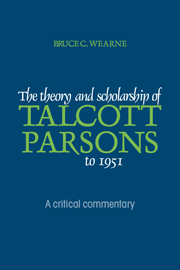Book contents
- Frontmatter
- Contents
- Preface
- Part 1 Unravelling Talcott Parsons' theoretical development
- Part 2 Talcott Parsons: the roots of his thought
- Part 3 The development of theory
- 4 Max Weber and the vision of a unified social science
- 5 The position and prospects of sociology at Harvard in the 1930s
- 6 Convergence and its construction
- Part 4 The theory
- Part 5 Parsons' theory as it stood at 1951
- Appendix Some recent publishing on Talcott Parsons' theory: a bibliographical essay
- List of references
- Index of names
- Index of Parsonian concepts
5 - The position and prospects of sociology at Harvard in the 1930s
Published online by Cambridge University Press: 05 February 2012
- Frontmatter
- Contents
- Preface
- Part 1 Unravelling Talcott Parsons' theoretical development
- Part 2 Talcott Parsons: the roots of his thought
- Part 3 The development of theory
- 4 Max Weber and the vision of a unified social science
- 5 The position and prospects of sociology at Harvard in the 1930s
- 6 Convergence and its construction
- Part 4 The theory
- Part 5 Parsons' theory as it stood at 1951
- Appendix Some recent publishing on Talcott Parsons' theory: a bibliographical essay
- List of references
- Index of names
- Index of Parsonian concepts
Summary
Parsons' scholarly engagement at Harvard during the 1930s
How did Parsons ‘fit in’ with the Harvard of the 1930s? We can answer this question by looking at the collection of journal articles which were published at this time. They represent the progressive refinement of an argument which came to culmination in The Structure of Social Action. In that work he achieved his ‘quantum leap’ from ‘theories’ to ‘theory’. He had also established himself at Harvard.
We must now consider how Parsons came to view himself as a theorist. Harvard required original work of its faculty (Morison 1936: 53ff.). It sought out ‘first raters’. In this competitive atmosphere Parsons finally produced ‘the book’. There was more than just institutional pressure from ‘without’; Parsons laboured to produce an original response to the intellectual environment of the American university, from within the discipline of economics.
Parsons acknowledged that he was a ‘maverick’. He fought a running battle against rigid lines of division between disciplines (T. Parsons 1959: 5–6, n. 3).
For there is absolutely no reason to suppose that concrete action is divided up into water-tight compartments, each dominated by radically different principles. Only the relatively high degree of differentiation of modern western society has enabled this illusion to stand up as long as it has, and now it has definitely broken down. Human life is essentially one and no concretely possible degree of functional differentiation can destroy its unity.
(T. Parsons 1935a: 660)- Type
- Chapter
- Information
- The Theory and Scholarship of Talcott Parsons to 1951A Critical Commentary, pp. 61 - 75Publisher: Cambridge University PressPrint publication year: 1990



